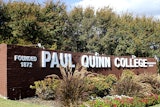 Richard Culatta, acting director of the Office of Educational Technology at the Department of Education, argued that if used correctly, technology can enhance how the classroom functions.
Richard Culatta, acting director of the Office of Educational Technology at the Department of Education, argued that if used correctly, technology can enhance how the classroom functions.WASHINGTON — An Obama administration official stressed on Wednesday during The Atlantic’s “Technology in Education Forum” that as educators move to infuse technology into the classroom, they should do it to transform how learning takes place and not to simply “digitize” conventional methods.
“Technology has an important role,” said Richard Culatta, acting director of the Office of Educational Technology at the U.S. Department of Education. “But by default, if we don’t make better choices and better decisions about how we use it, it will be used to digitize the traditional mode.
“So instead of chalkboards, we’ll have digital chalkboards,” Culatta continued. “We need to make some really conscious decisions and say there’s a better route to reinvent learning.
Culatta made his remarks at a panel discussion titled “Reimagining Educational Opportunity: College and Workforce Preparation.” The discussion ranged from the “moving target” of technology skills that students need to access jobs in the technology sphere to how corporate partnerships with institutions of higher education can help provide more real-world learning for students.
“School needs to look and feel much more different, more relevant and tied to what students are able to do when they leave school,” said Culatta.
Among other things, Culatta touted the emergence of “learning positional systems,” a GPS, so to speak, of a student’s educational journey.
“I know where you are [and] where you’re going,” he said. “I’ll give you context and plot a way to get you there and, when you get off track, redirect the path back.”
Nicole Smith, research professor and senior economist at the Georgetown University Center on Education and the Workforce, said the learning positional systems that Culatta cited are “exactly” the type of thing that is needed in higher education to help students better traverse their way toward a bachelor’s degree.
“The B.A. is not necessarily the only objective of learning,” she said. “If we could look at things in bite-size pieces, perhaps look at stepping stones, then we could take each type of action movement for this straight pathway that you define as an opportunity to get ourselves through the long term objective of trying to get a job.”
Smith added, “We would like to figure out what is the best way of ensuring that you don’t lose people in the pipeline, that you don’t just drop out but find a learning system that is unique for them and increases diversity, so that everyone has an opportunity.”
Assistant Vice President for Education Leadership at AT&T Charles Herget announced a new collaboration between AT&T, online education provider Udacity and the Georgia Institute of Technology College of Computing that will offer what was described as the first online master of science degree in computer science, or an OMS CS, that can be earned completely through a new Massive Open Online Course, or MOOC.
Herget said the new collaboration will lead to “transformations in the higher ed space because it’s the first program that will allow utilizing the MOOC platform.”
According to Herget, MOOC will make the degree from Georgia Tech accessible in that students no longer have to travel to the university’s campus in Atlanta to take the course. It will allow for more flexibility because students can work at their own pace, and more affordable because it reduces the cost of a $40,000 program to $7,000.
Roughly half the class will be comprised of current AT&T employees who are using it to advance their careers. Herget said the company would “absolutely” hire other students who take the course.
Tammy Wincup, chief operating officer at EverFi, listed a number of trends that she said are “going to change the conversation” about education innovation.
“The first is that the conversation about education innovation has become mainstream,” she said. “It’s not a conversation like school choice or other things like that with certain populations of the community.”
Wincup also said that educational technology is enabling students to produce a “new resume” of themselves that features various aspects of their learning — such as learning “badges” they earned in particular programs — that they can present to employers.
And whereas in the past, most people moved to where the jobs were, today that is true of college-educated individuals. “Over 50 percent of college educated move to a different place from where they graduated,” Wincup said.
The challenge, she said, is to bring education innovation to places that have historically gotten the short end of the stick.


















